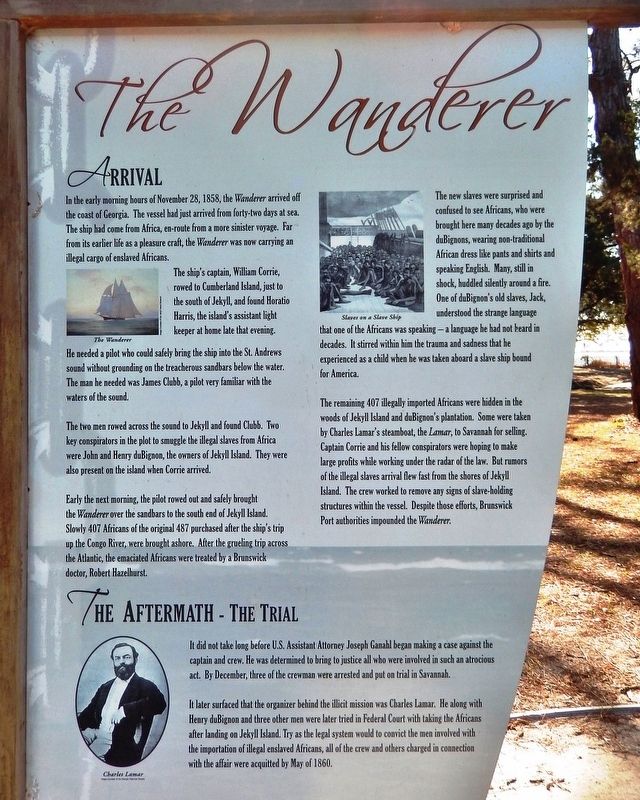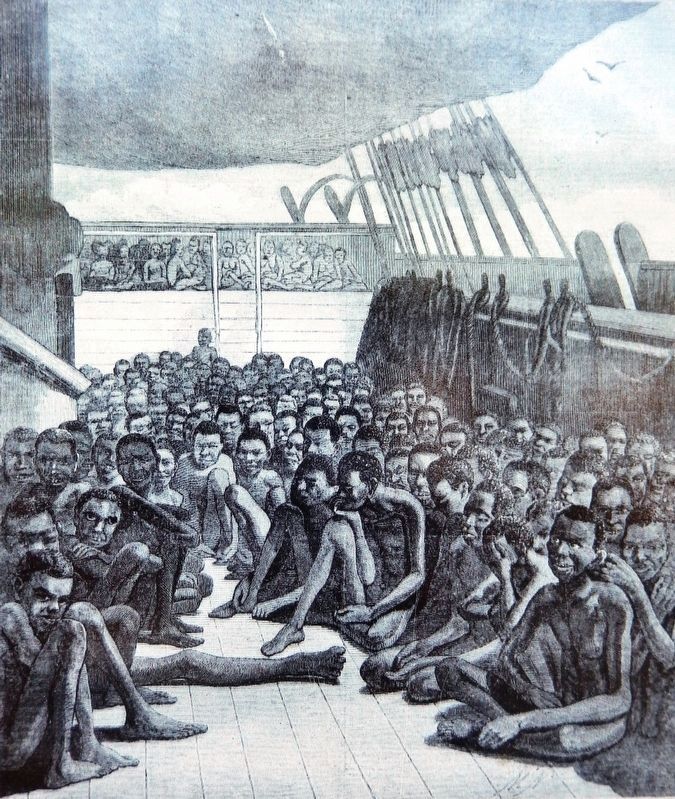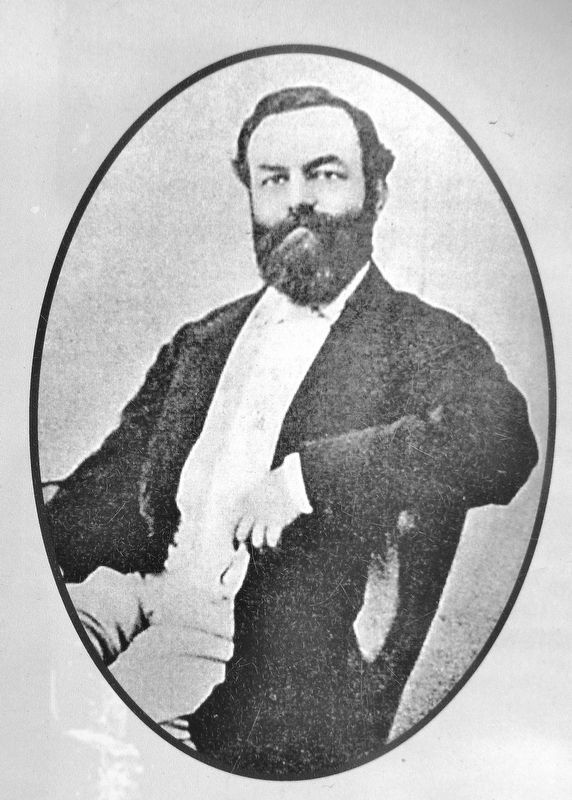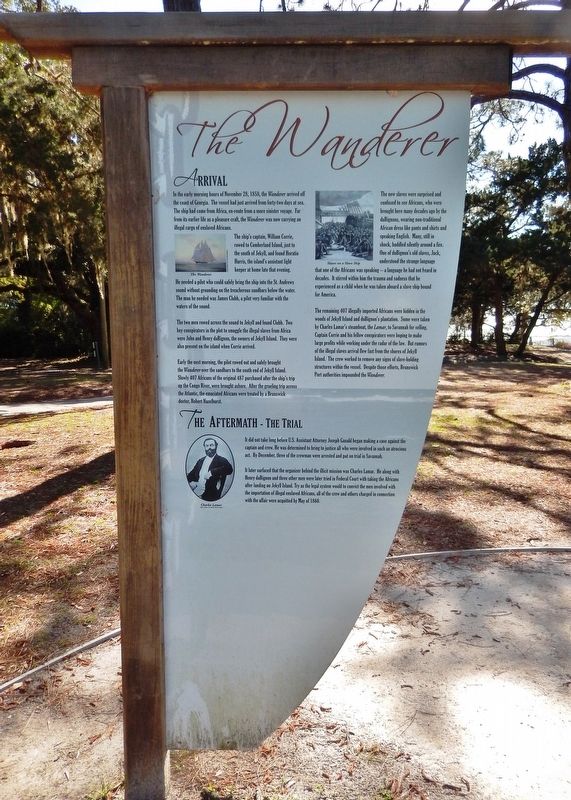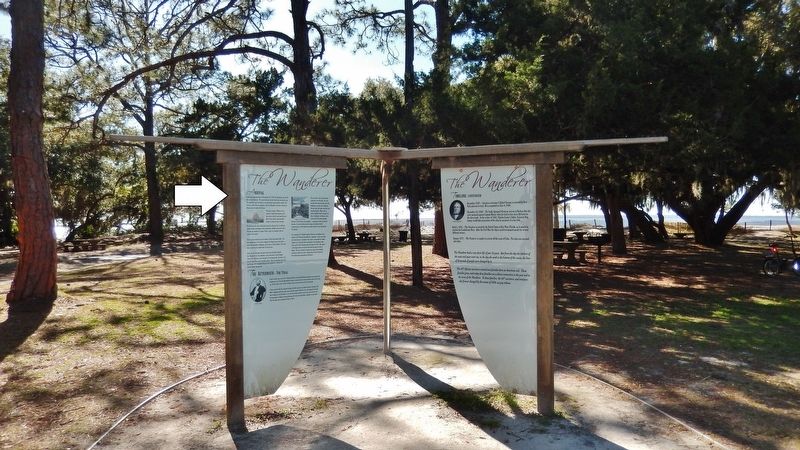Jekyll Island in Glynn County, Georgia — The American South (South Atlantic)
The Wanderer Arrival
In the early morning hours of November 28, 1858, the Wanderer arrived off the coast of Georgia. The vessel had just arrived from forty-two days at sea. The ship had come from Africa, en-route from a more sinister voyage. Far from its earlier life as a pleasure craft, the Wanderer was now carrying an illegal cargo of enslaved Africans.
The ship's captain, William Corrie, rowed to Cumberland Island, just to the south of Jekyll, and found Horatio Harris, the island's assistant light keeper at home late that evening. He needed a pilot who could safely bring the ship into the St. Andrews sound without grounding on the treacherous sandbars below the water. The man he needed was James Clubb, a pilot very familiar with the waters of the sound.
The two men rowed across the sound to Jekyll and found Clubb. Two key conspirators in the plot to smuggle the illegal slaves from Africa were John and Henry duBignon, the owners of Jekyll Island. They were also present on the island when Corrie arrived.
Early the next morning, the pilot rowed out and safely brought the Wanderer over the sandbars to the south end of Jekyll Island. Slowly 407 Africans of the original 487 purchased after the ship's trip up the Congo River, were brought ashore. After the grueling trip across the Atlantic, the emaciated Africans were treated by a Brunswick doctor, Robert Hazelhurst.
The new slaves were surprised and confused to see Africans, who were brought here many decades ago by the duBignons, wearing non-traditional African dress like pants and shirts and speaking English. Many, still in shock, huddled silently around a fire. One of duBignon's old slaves, Jack, understood the strange language that one of the Africans was speaking a language he had not heard in decades. It stirred within him the trauma and sadness that he experienced as a child when he was taken aboard a slave ship bound for America.
The remaining 407 illegally imported Africans were hidden in the woods of Jekyll Island and duBignon's plantation. Some were taken by Charles Lamar's steamboat, the Lamar, to Savannah for selling. Captain Corrie and his fellow conspirators were hoping to make large profits while working under the radar of the law. But rumors of the illegal slaves arrival flew fast from the shores of Jekyll Island. The crew worked to remove any signs of slave-holding structures within the vessel. Despite those efforts, Brunswick Port authorities impounded the Wanderer.
The Aftermath The Trial
It did not take long before U.S. Assistant Attorney Joseph Ganahl began making a case against the captain and crew. He was determined to bring to justice all who were involved in such an atrocious act. By December, three of the crewman were arrested and put on trial in Savannah.
It later surfaced that the organizer behind the illicit mission was Charles Lamar. He along with Henry duBignon and three other men were later tried in Federal Court with taking the Africans after landing on Jekyll Island. Try as the legal system would to convict the men involved with the importation of illegal enslaved Africans, all of the crew and others charged in connection with the affair were acquitted by May of 1860.
Erected by State of Georgia.
Topics. This historical marker is listed in these topic lists: African Americans • Industry & Commerce • Law Enforcement • Waterways & Vessels. A significant historical date for this entry is November 28, 1858.
Location. 31° 1.284′ N, 81° 26.04′ W. Marker is on Jekyll Island, Georgia, in Glynn County. Marker can be reached from Beach View Drive, 0.1 miles north of South Riverview Drive. Marker is located in The Wanderer interpretive kiosk, just north of the parking lot at St. Andrews Beach Park. Touch for map. Marker is at or near this postal address: 1 South Riverview Drive, Jekyll Island GA 31527, United States of America. Touch for directions.
Other nearby markers. At least 8 other markers are within walking distance of this marker. The Wanderer Built For Speed (here, next to this marker); The Wanderer What Happened to the Survivors: Their Stories (here, next to this marker); The Wanderer Cilucangy: Ward Lee (here, next to this marker); The Wanderer Timeline: Continued (here, next to this marker); The Wanderer Timeline (here, next to this marker); Wanderer Memory Trail (a few steps from this marker); Survivors of the Wanderer (a few steps from this marker); Taken From Africa (within shouting distance of this marker). Touch for a list and map of all markers in Jekyll Island.
Related markers. Click here for a list of markers that are related to this marker. Wanderer Memory Trail
Also see . . .
1. Wanderer's Service in the Slave Trade. Wikipedia entry:
Wanderer crossed the Atlantic Ocean to Africa, and entered the Congo River on 16 September 1858. Braving an epidemic of yellow fever which was then raging in the Congo, she took on board some 500 Africans and sailed for North America. At the end of a six-week voyage in which many of the captives died, Wanderer arrived at Jekyll Island, Georgia, on 28 November 1858 and delivered her human cargo. (Submitted on March 12, 2021, by Cosmos Mariner of Cape Canaveral, Florida.)
2. Aftermath of the Wanderer. New Georgia Encyclopedia website entry:
As a result of the inquiry, Lamar, Corrie, and his conspirators were tried in federal court in Savannah on three separate counts of piracy in May 1860. Prosecutors were unsuccessful in proving their case, however, and the local jury returned a verdict of not guilty. No doubt Lamar's status as one of Savannah's leading citizens played a pivotal role in the acquittal. (Submitted on March 12, 2021, by Cosmos Mariner of Cape Canaveral, Florida.)
Additional keywords. The Wanderer Arrival
Credits. This page was last revised on April 6, 2024. It was originally submitted on March 12, 2021, by Cosmos Mariner of Cape Canaveral, Florida. This page has been viewed 491 times since then and 61 times this year. Photos: 1, 2, 3, 4, 5, 6. submitted on March 12, 2021, by Cosmos Mariner of Cape Canaveral, Florida.
